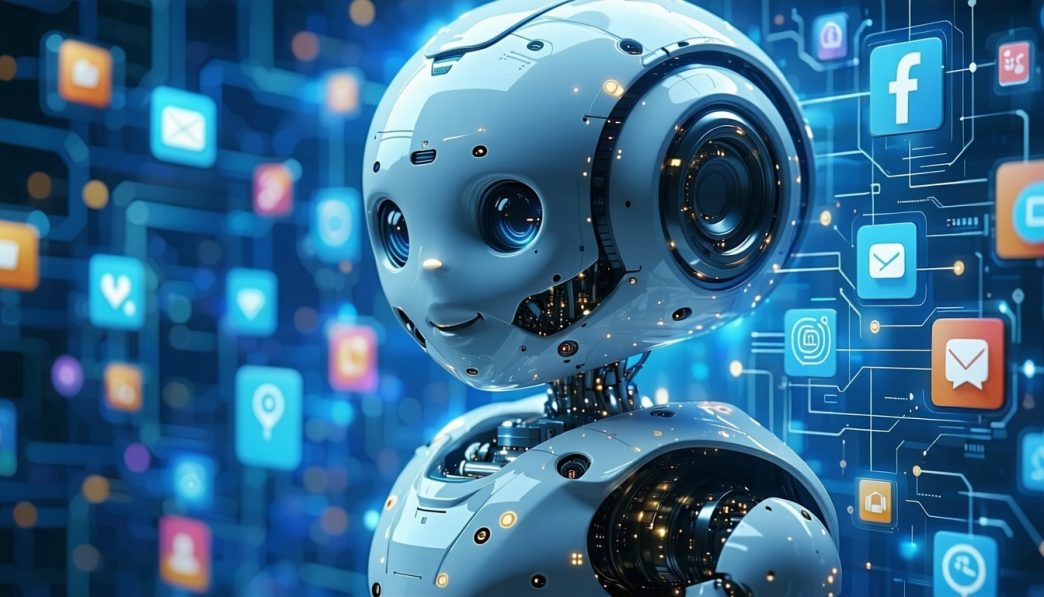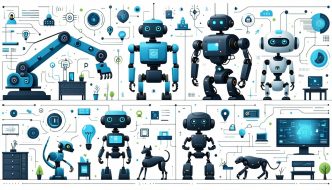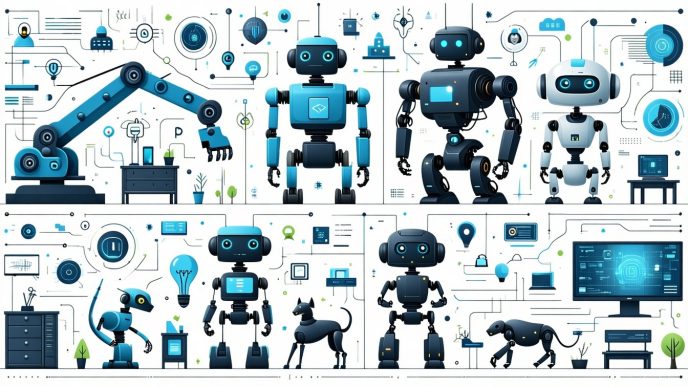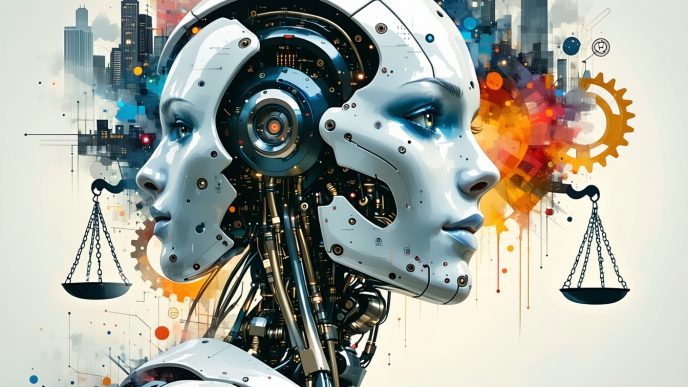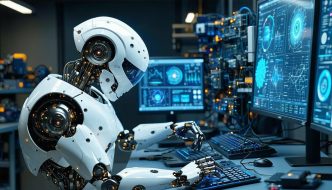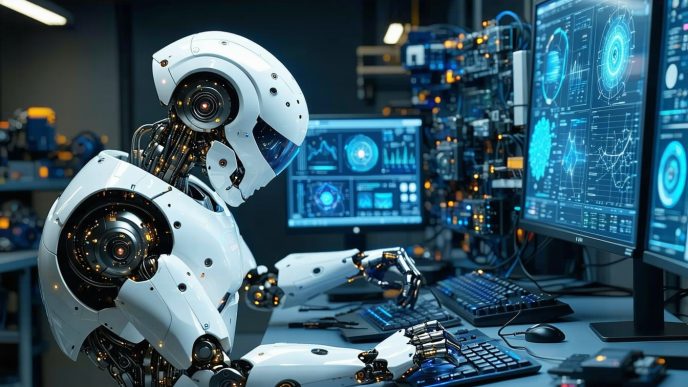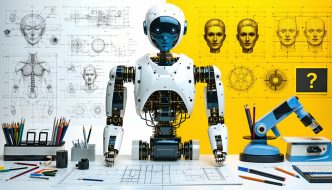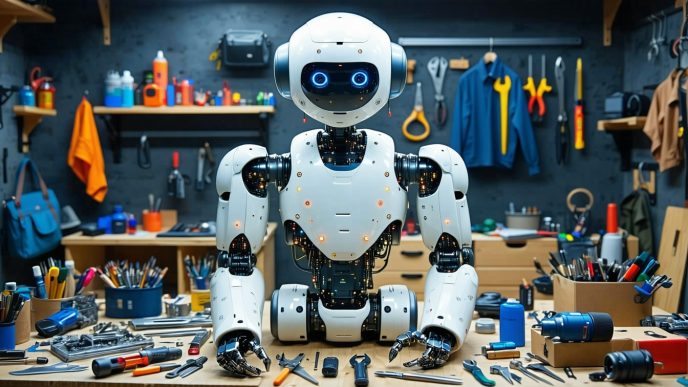Understanding Humanoid Robots
Humanoid robots have gained prominence in various sectors due to their unique characteristics and capabilities. This section provides a detailed understanding of what humanoid robots are, their evolution over time, and their significance across industries.
Definition of Humanoid Robots
Humanoid robots are machines designed to replicate human appearance and behavior. They feature a head, torso, arms, and legs, which allow them to perform tasks similar to those of humans. Their design often aims to enhance interactions with people, making them more relatable and intuitive in function. They can engage in conversation, perform manual tasks, and even express emotions to a certain extent.
| Feature | Description |
|---|---|
| Structure | Mimics human anatomy with head, torso, arms, and legs |
| Function | Designed to perform tasks usually associated with people |
| Interaction | Capable of communication and emotional expression |
Evolution of Humanoid Robotics
The field of humanoid robotics has seen significant advancements since its inception. Early models focused on basic movements and predefined tasks. Over the years, improvements in artificial intelligence, machine learning, and sensor technology have led to more sophisticated designs.
| Year | Milestone |
|---|---|
| 1950s | Early mechanical robots emerge |
| 1990s | Introduction of autonomous humanoid robots |
| 2000s | Development of robots with enhanced AI capabilities |
| 2010s | Proliferation of humanoid robots in various sectors |
The transition from simple machines to complex robots signifies a shift not only in technology but also in understanding human-robot interaction.
Importance of Humanoid Robots in Various Industries
Humanoid robots have found applications in a range of industries, enhancing productivity, safety, and efficiency. These robots assist in areas such as:
- Healthcare: Providing companionship and support for patients as seen in humanoid robots in healthcare.
- Education: Engaging students and facilitating learning experiences through interactive methods, as explored in humanoid robots for education.
- Customer Service: Serving as front-line assistants in retail environments, improving customer experience.
The integration of humanoid robots continues to transform industries by streamlining operations and introducing innovative technologies.
Humanoid robots represent a fascinating intersection of technology and human-like interaction, unlocking numerous possibilities within various fields. To learn more about how these robots operate within ecosystems, read about humanoid robot app ecosystems.
Humanoid Robot Skills and Capabilities
Humanoid robots are designed with various skills and capabilities, enabling them to perform tasks that assist humans in different contexts. Understanding their current abilities, limitations in skill acquisition, and challenges in enhancing their skills is crucial for future developments.
Current Skill Sets of Humanoid Robots
Today’s humanoid robots possess a range of basic skills that allow them to function in various environments. These skill sets can include:
| Skills | Description |
|---|---|
| Mobility | Ability to walk, run, and navigate over obstacles. |
| Manipulation | Capability to grasp, lift, and move objects using robotic arms. |
| Communication | Use of voice interfaces and basic conversation skills. |
| Navigation | Ability to map surroundings and avoid obstacles. |
| Basic Learning | Simple learning algorithms to adapt to new tasks or environments. |
These skills enable humanoid robots to assist in settings like homes, healthcare, and logistics. For example, humanoid robots for home use can perform daily chores, while those in healthcare assist with elder care as seen in humanoid robots in elder care.
Limitations in Skill Acquisition
Despite advancements, humanoid robots face limitations in their ability to acquire new skills autonomously. Some challenges include:
| Limitations | Description |
|---|---|
| Technological Constraints | Difficulty in developing complex algorithms for advanced learning. |
| Physical Limitations | Restriction in performing tasks that require dexterity and fine motor skills. |
| Data Requirements | Need for vast amounts of data for effective learning, which may not be available. |
These limitations can hinder their deployment in various industries. For instance, while humanoid robots for security can perform surveillance, they may struggle with tasks that require situational understanding.
Challenges in Enhancing Skills
Enhancing the skills of humanoid robots presents several challenges:
| Challenges | Description |
|---|---|
| Integration of AI Models | Need for advanced AI to facilitate learning and adaptability. |
| Hardware Constraints | Restrictions in sensor technologies and processing power for real-time learning. |
| Safety Concerns | Ensuring that enhanced capabilities do not compromise human safety. |
Addressing these challenges is essential for future innovations in humanoid robot app ecosystems. The integration of resources, such as neuralink and humanoid integration, may provide pathways for more sophisticated skill enhancement. As the field progresses, research into humanoid robot training systems, including methods of robot emotions and ethics, will be vital for ensuring safe and effective interactions.
App Ecosystems for Humanoid Robots
As humanoid robots continue to advance, the concept of app ecosystems tailored specifically for them has emerged. These ecosystems play a vital role in enhancing the functionality and versatility of humanoid robots.
Overview of App Ecosystems for Robots
App ecosystems for humanoid robots operate similarly to those found in smartphones and tablets. They consist of various applications and programs that can be downloaded to improve robot performance, expand capabilities, and personalize interactions. These ecosystems enable robots to access a wide range of functionalities, from simple task management to complex problem solving.
The integration of app ecosystems allows developers to create specialized applications that address specific needs and industries. For instance, a humanoid robot designed for elder care may include apps focused on health monitoring, communication, and companionship. This adaptability makes humanoid robots more effective and user-friendly.
Benefits of App Ecosystems for Humanoid Robots
The advantages of implementing app ecosystems for humanoid robots are significant:
| Benefit | Description |
|---|---|
| Customization | Users can download apps tailored to their needs, enhancing the robot’s functionality. |
| Enhanced Learning | Robots can access a variety of learning tools and modules, improving skill acquisition. |
| Sector-Specific Applications | Developers can create industry-specific apps, making robots more valuable in fields like healthcare, education, and security. |
| Regular Updates | Software updates can be easily deployed via the app ecosystem, ensuring robots remain current with new features and functionalities. |
| Interoperability | Different robots can utilize the same app, promoting collaboration and compatibility across systems. |
With the rise of humanoid robot app ecosystems, the potential for customization and enhanced capabilities becomes increasingly promising. As robots continue to integrate more seamlessly into daily life, the function and utility provided by these ecosystems will play an essential role in their development. For further insights into humanoid robotics, consider exploring topics on humanoid robots for home use and humanoid robots for education.
Training and Skill Download Process
The process by which humanoid robots acquire new skills is a crucial area of research in robotics. This section will discuss how robots learn new abilities, the potential for skill downloads similar to mobile applications, and the technical implications of such advancements.
How Robots Learn New Skills
Humanoid robots currently learn new skills through a combination of programming, machine learning, and real-time feedback from their environment. This process involves several techniques, including but not limited to:
- Supervised Learning: Robots are trained using labeled datasets where the desired outcomes are clearly defined.
- Reinforcement Learning: Robots learn through trial and error, receiving rewards for successful task completion and penalties for mistakes.
- Imitation Learning: By observing human actions, robots can mimic behaviors, thus learning new skills in a more intuitive manner.
The learning process can be slow and often requires extensive data and computing resources. A summary of the learning methods and their characteristics is presented in the table below:
| Learning Method | Description | Example Use Case |
|---|---|---|
| Supervised Learning | Learning from labeled examples | Object recognition |
| Reinforcement Learning | Learning from feedback on actions | Navigation in unknown environments |
| Imitation Learning | Learning from observing humans | Social interaction skills |
Possibilities of Skill Download like Apps
The concept of enabling robots to download skills akin to mobile app installations presents an intriguing possibility for the future of humanoid robotics. Such a system could simplify the update and installation of new functionalities, allowing robots to adapt to diverse tasks and environments rapidly.
This approach would likely leverage advanced programming frameworks and large online repositories of skills, similar to humanoid robot app ecosystems. These ecosystems could allow developers to create and share skills that robots can then access and download as needed. This could significantly accelerate the learning process and expand the capabilities of humanoid robots.
Technical Implications of Skill Download
Implementing a skill download feature akin to app stores presents several technical challenges and implications. Key considerations include:
- Data Storage and Processing: Robots would need sufficient onboard memory and processing power to handle downloaded skills effectively.
- Security: Protecting against malicious software or corrupted skills would be crucial to ensure safe operation.
- Compatibility and Updates: Skills would need to be compatible with different robot architectures, requiring standardized formats and frequent updates.
A speculative overview of the potential system requirements for skill downloads is illustrated in the table below:
| Requirement | Description |
|---|---|
| Memory Capacity | Sufficient storage for multiple skills |
| Processing Power | CPU/GPU capabilities to execute complex skills |
| Update Mechanism | System for regular updates and skill management |
| Security Protocols | Measures to protect from external threats |
By addressing these technical implications, researchers can pave the way for a future where humanoid robots can acquire new skills quickly and effectively, likely altering their role in various sectors, from healthcare to home assistance and beyond.
Ethical Considerations
The introduction of humanoid robots with advanced skills has raised several ethical concerns. These considerations are crucial as technology progresses toward the possibility of downloading skills in a manner similar to mobile applications.
Impact of Rapid Skill Acquisition
The capability for humanoid robots to rapidly acquire new skills has significant implications. While this could enhance productivity and efficiency, it also raises questions about the potential for misuse. For instance, if robots can quickly learn tasks such as surveillance or complex decision-making, there is concern over privacy violations and the extent of their autonomy. Understanding the societal impact of such rapid skill applications is essential for creating a framework that ensures responsible use.
| Potential Impacts of Rapid Skill Acquisition | Description |
|---|---|
| Increased Efficiency | Robots can perform tasks faster, improving productivity in various sectors like healthcare and logistics. |
| Privacy Risks | Rapid acquisition of surveillance skills may lead to unauthorized monitoring of individuals. |
| Job Displacement | Automation of roles traditionally held by humans might lead to job loss in certain industries. |
Safety Concerns with Downloadable Skills
The integration of downloadable skills also brings safety issues to the forefront. If humanoid robots are equipped with complex capabilities without rigorous testing, they could pose risks to humans and their environments. For example, a robot learning to handle machinery must be programmed with safeguards to prevent accidents. As these robots operate in homes and public spaces, establishing comprehensive safety standards is vital. For further insight into safety systems for humanoid robots, refer to our article on humanoid robot safety systems.
| Safety Considerations | Details |
|---|---|
| Ensuring Reliability | Downloaded skills must be tested for reliability to prevent malfunction. |
| Risk Assessment | Continuous risk assessments of skills in real-time environments are necessary. |
| Emergency Protocols | Robots should be equipped with protocols to handle unexpected situations. |
Integration of Ethical Standards in Skill Downloads
As humanoid robots evolve, integrating ethical standards in the skill download process is critical. This involves creating guidelines that address the ethical implications of skill acquisition. Stakeholders, including developers, policymakers, and ethicists, must collaborate to establish norms that govern robot behavior and ensure alignment with human values. For a deeper discussion on ethical considerations surrounding robots, see our article on robot emotions and ethics.
| Ethical Standards | Objectives |
|---|---|
| Transparency | Ensure that the algorithms behind skill downloads are transparent and understandable. |
| Accountability | Establish clear guidelines for accountability when robots misuse learned skills. |
| Inclusion | Engage diverse perspectives in developing ethical frameworks to cater to various societal views. |
The ethical considerations surrounding humanoid robots and their potential to download skills present both challenges and opportunities for society. Addressing these issues proactively can help guide the responsible development and integration of humanoid robot app ecosystems into daily life.
Future of Humanoid Robots
The future of humanoid robots holds exciting possibilities as technology continues to advance. Predictions about their development, advancements in skills enhancement, and societal roles in regulating these features are above all vital for ensuring a balanced evolution.
Predictions for Humanoid Robot Development
Experts envision significant growth in humanoid robot capabilities within the next decade. Advances in artificial intelligence and machine learning are predicted to enable these robots to perform more complex tasks, mimicking human-like behavior more closely. As this progression unfolds, competition among various designs, such as the Apptronik Apollo and Tesla Optimus, will likely spur innovation.
| Timeline | Expected Developments |
|---|---|
| 2025 | Improved emotional recognition capabilities |
| 2030 | Enhanced dexterity for complex tasks |
| 2035 | Advanced automation in everyday settings |
Potential Advancements in Skill Enhancement
Humanoid robots will likely benefit from an evolving app ecosystem tailored specifically for their capabilities. This could include downloadable skill modules that allow them to learn new tasks, similar to how applications function on mobile devices. Innovations in humanoid robot software platforms and integrations with neural interfaces are essential areas of focus.
| Skill Type | Potential Applications |
|---|---|
| Household Tasks | Cooking, cleaning, and organizing |
| Companionship | Providing emotional support |
| Security | Monitoring and ensuring safety |
Society’s Role in Regulating Skill Downloads
As humanoid robots become more integrated into everyday life, the role of society in regulating their development and capabilities will be crucial. Ethical considerations surrounding the deployment of humanoid robot app ecosystems, including privacy and safety standards, must be addressed. Engaging with the community to formulate regulations and best practices will help ensure responsible innovation.
| Regulatory Focus | Importance |
|---|---|
| Data Privacy | Protecting user information |
| Safety Standards | Ensuring safe interactions |
| Ethical Guidelines | Establishing acceptable usage policies |
By anticipating advancements in humanoid robots and understanding the societal implications, users can better navigate the evolving landscape of robot capabilities. The integration of technology and community input will pave the way for the responsible development of humanoid robot app ecosystems.


